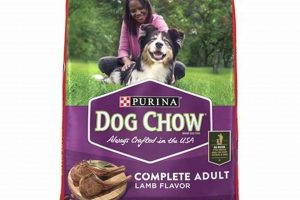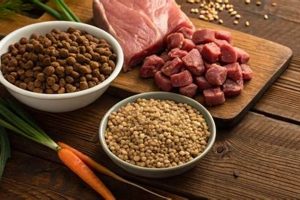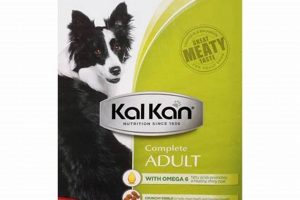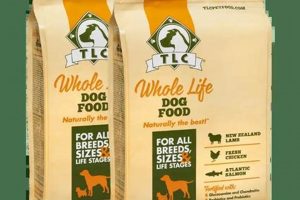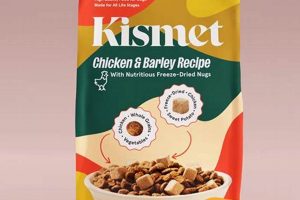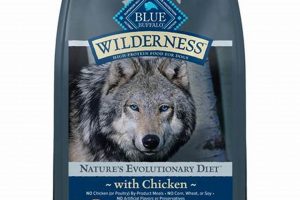Following dental procedures, a dog’s ability to comfortably consume regular kibble is often compromised. A diet consisting of easily digestible, soft foods is crucial during the recovery period. This type of nourishment minimizes chewing and reduces the risk of irritating the surgical site, thereby promoting faster healing and reducing pain. For example, options such as blended cooked chicken with rice or a veterinary-approved soft food formula are frequently recommended.
Providing appropriate nutrition during this sensitive time is paramount for several reasons. It ensures the animal receives necessary nutrients for tissue repair and overall well-being. It minimizes discomfort, encouraging the dog to eat and maintain strength. Historically, owners resorted to softening kibble, but carefully prepared meals offer greater control over ingredients and texture, further tailoring the diet to the dog’s specific needs and minimizing potential complications.
The subsequent sections will delve into suitable ingredient selection, preparation methods, and considerations regarding nutritional balance and veterinary consultation to facilitate a smooth and effective dietary transition post-surgery. These factors are essential for owners seeking to provide optimal care for their canine companions.
Considerations for Post-Dental Surgery Canine Nutrition
The following guidelines offer practical advice for managing a dog’s diet following dental surgery, aimed at promoting comfort and facilitating optimal healing.
Tip 1: Prioritize Soft Textures: Select ingredients that can be easily mashed or blended into a smooth consistency. Avoid any food requiring significant chewing, which could irritate the surgical site.
Tip 2: Hydration is Critical: Ensure adequate water intake to prevent dehydration, especially if the dog is reluctant to eat. Consider adding low-sodium broth to meals to increase moisture content and palatability.
Tip 3: Introduce New Foods Gradually: To prevent digestive upset, introduce the post-operative diet in small portions. Gradually increase the amount as the dog tolerates the food.
Tip 4: Monitor for Signs of Discomfort: Observe the dog’s eating behavior closely. If there are signs of pain, difficulty swallowing, or regurgitation, consult a veterinarian immediately.
Tip 5: Opt for Bland, Easily Digestible Ingredients: Chicken, white rice, sweet potato, and plain yogurt are typically well-tolerated and provide essential nutrients without irritating the digestive system.
Tip 6: Maintain Nutritional Balance: While prioritizing soft textures, ensure the diet provides adequate protein, carbohydrates, and fats. Supplementation may be necessary if the diet is limited to a few ingredients for an extended period. Veterinary guidance is recommended.
Tip 7: Avoid Small, Hard Particles: Eliminate any ingredients containing small bones, seeds, or tough skin that could become lodged in the surgical site and impede healing.
Adhering to these tips helps minimize discomfort, promotes healing, and ensures the dog receives essential nutrients during the recovery period. However, always remember that tailoring the diet according to the dog’s specific health condition and consulting a veterinarian is paramount.
The ensuing discussion will address potential complications, long-term dietary considerations, and the importance of ongoing veterinary oversight to guarantee sustained well-being following dental procedures.
1. Soft Texture
Following dental surgery, a dog’s ability to chew is significantly impaired. Therefore, soft texture becomes a paramount consideration in the preparation of their food, specifically when considering homemade options. The consistency of the food directly influences the dog’s comfort level, appetite, and the potential for complications during recovery.
- Reduced Strain on Surgical Site
A soft texture minimizes the need for chewing, thereby reducing pressure and strain on the surgical site. Hard or crunchy foods can irritate the gums, leading to inflammation, pain, and potentially disrupting sutures. A smooth consistency allows the dog to consume food with minimal manipulation in the mouth, promoting faster healing.
- Enhanced Palatability for Pain Management
Dental surgery often results in pain and discomfort, which can significantly reduce a dog’s appetite. Soft textured foods are generally more palatable as they require less effort to consume. Broths or pureed mixtures can stimulate appetite while simultaneously providing essential nutrients and hydration.
- Ease of Digestion
Often, post-operative medications can disrupt a dog’s digestive system. Soft foods are typically easier to digest, reducing the risk of gastrointestinal upset. Ingredients such as well-cooked rice, boiled chicken, or steamed vegetables are easily broken down, minimizing the strain on the digestive tract.
- Prevention of Food Impaction
The surgical site is susceptible to food particles becoming lodged and causing infection or inflammation. Soft textures reduce the risk of food impaction as they are less likely to fragment into small, hard pieces that could become trapped. The smoother consistency aids in easy swallowing and reduces the likelihood of complications.
In conclusion, the provision of a soft-textured diet is not merely a preference but a crucial element in post-operative care after dental surgery. It directly impacts the dog’s comfort, healing process, and overall well-being. Careful consideration of ingredients and preparation techniques is essential to ensure the dog receives adequate nutrition without compromising the integrity of the surgical site.
2. Easy digestion
Post-dental surgery, a dog’s digestive system may be particularly sensitive. Therefore, easy digestion is a critical factor when formulating a homemade diet during this recovery period. The goal is to minimize gastrointestinal upset and ensure efficient nutrient absorption.
- Reduced Fiber Content
High-fiber diets, while beneficial for general canine health, can be problematic immediately following surgery. Fiber can increase stool volume and potentially strain the abdominal muscles, causing discomfort. A diet consisting of easily digestible proteins, carbohydrates, and limited fiber reduces the workload on the digestive tract. Examples include well-cooked white rice, lean ground turkey, and small amounts of cooked, skinless sweet potato.
- Hydrolyzed Proteins
Hydrolyzed proteins are broken down into smaller peptide fragments, making them easier to absorb and less likely to trigger an immune response. While less common in standard homemade diets, incorporating sources of highly digestible protein, such as boiled chicken or fish, minimizes the risk of allergic reactions or digestive inflammation. Commercial hydrolyzed protein diets offer an alternative option.
- Minimizing Fat Content
High-fat foods can be difficult for dogs to digest, particularly post-anesthesia. Reduced fat content ensures quicker gastric emptying and reduces the likelihood of pancreatitis or diarrhea. Lean protein sources and minimal added fats are recommended. Avoid rich sauces, gravies, or oily ingredients.
- Probiotics and Prebiotics
Dental surgery and associated medications, such as antibiotics, can disrupt the gut microbiome. Incorporating probiotics (live beneficial bacteria) and prebiotics (non-digestible fibers that feed beneficial bacteria) can help restore balance to the digestive system. Plain, unsweetened yogurt with active cultures is a readily available source of probiotics. Cooked and cooled white rice can act as a prebiotic, supporting the growth of beneficial bacteria.
Prioritizing easily digestible ingredients and preparation methods is paramount in managing a dog’s nutritional needs following dental surgery. The goal is to support healing, minimize discomfort, and prevent gastrointestinal complications. Careful ingredient selection, appropriate cooking techniques, and potential supplementation with probiotics or prebiotics contribute to a successful dietary transition during the recovery period.
3. Nutrient Balance
Following dental surgery, a dog’s dietary needs are significantly altered, necessitating a focus on easily digestible and palatable foods. The creation of a homemade diet during this period requires careful attention to nutrient balance to facilitate healing and prevent nutritional deficiencies. An inadequate or imbalanced diet can impede recovery, weaken the immune system, and prolong the convalescence period. For instance, insufficient protein intake can hinder tissue repair at the surgical site, while inadequate calcium and phosphorus can compromise bone health, particularly in cases involving tooth extractions or jaw modifications.
A well-balanced homemade diet for post-operative dental patients should incorporate sufficient protein from sources such as cooked chicken or lean ground turkey to support tissue regeneration. Complex carbohydrates like cooked white rice or sweet potato provide energy without causing digestive distress. Essential fatty acids, sourced from fish oil or flaxseed oil, are crucial for reducing inflammation and supporting immune function. Furthermore, appropriate levels of vitamins and minerals, obtainable through supplementation or carefully selected vegetables, are essential for optimal physiological function. Examples of balanced recipes include a mixture of boiled chicken, rice, and steamed carrots, supplemented with a small amount of fish oil, or a blend of lean ground turkey, cooked sweet potato, and plain yogurt, ensuring the dog receives adequate nutrition in a palatable and digestible form. The exclusion of processed ingredients and potential allergens further enhances digestive tolerance.
Achieving nutrient balance in a homemade diet following dental surgery presents several challenges. It requires a thorough understanding of canine nutritional requirements and the potential impact of individual ingredients. Consultation with a veterinary nutritionist is strongly recommended to ensure the diet meets the dog’s specific needs and avoids potential deficiencies or excesses. This tailored approach maximizes the benefits of homemade feeding while mitigating the risks associated with nutritional imbalances, ultimately contributing to a more effective and comfortable recovery process after dental procedures.
4. Veterinary Approval
The creation and implementation of a homemade diet for canines following dental surgery necessitates the endorsement of a qualified veterinarian. This professional oversight ensures the nutritional adequacy and safety of the dietary regimen, mitigating potential risks associated with imbalances or inappropriate ingredient selections during a critical recovery period.
- Ensuring Nutritional Adequacy
A veterinarian assesses the specific nutritional requirements of the dog based on its age, breed, weight, pre-existing conditions, and the extent of the dental procedure performed. This evaluation informs the composition of the homemade diet, ensuring it provides sufficient protein, carbohydrates, fats, vitamins, and minerals essential for tissue repair and overall health. A generic recipe may lack crucial elements, leading to deficiencies that impede recovery.
- Mitigating Potential Risks
Certain ingredients, while generally safe for canines, may be contraindicated following dental surgery. For instance, foods high in acidity could irritate sensitive gums, while those with small, hard particles may become lodged in the surgical site, leading to infection. A veterinarian identifies and excludes such problematic ingredients, tailoring the diet to minimize the risk of complications. Furthermore, veterinarians are equipped to assess potential allergic reactions and adjust the diet accordingly.
- Individualized Dietary Adjustments
Dogs undergoing dental procedures often experience varying degrees of pain, inflammation, and appetite loss. A veterinarian monitors the dog’s response to the homemade diet and makes necessary adjustments to palatability, texture, and nutrient density. This individualized approach ensures the dog receives adequate nourishment despite potential challenges associated with the recovery process. Regular follow-up appointments allow for continuous evaluation and refinement of the dietary plan.
- Supplementation Guidance
Homemade diets, even when carefully formulated, may lack certain essential nutrients. A veterinarian recommends appropriate supplements to address these deficiencies, ensuring the diet provides a complete and balanced nutritional profile. The selection and dosage of supplements are determined based on the dog’s individual needs and the composition of the homemade food, preventing potential overdoses or interactions with medications.
In conclusion, veterinary approval serves as a crucial safeguard in the implementation of homemade diets for dogs recovering from dental surgery. It ensures the diet is nutritionally adequate, minimizes potential risks, and is tailored to the individual needs of the animal. This professional oversight optimizes the recovery process and promotes the dog’s overall well-being.
5. Hydration Support
Adequate hydration is a crucial aspect of post-operative care for dogs, particularly following dental surgery. Its importance is magnified when employing homemade food options, as these diets often require careful formulation to ensure sufficient fluid intake alongside essential nutrients.
- Increased Water Loss
Dental procedures and associated anesthesia can lead to increased water loss through panting or reduced ability to drink. Homemade diets can be formulated with higher moisture content than dry kibble. Adding water or low-sodium broth to the food increases fluid intake, mitigating dehydration risks. For example, a chicken and rice diet can be blended with broth to create a slurry consistency, providing both nourishment and hydration.
- Pain and Difficulty Drinking
Post-operative pain and discomfort can make it difficult for dogs to drink from their water bowl. Soft, moist foods alleviate this challenge by delivering fluids directly alongside sustenance. Homemade diets can be prepared in a soup-like consistency, making it easier for the dog to ingest and reducing discomfort. Observation of water intake is essential to ensure adequate hydration.
- Medication Considerations
Many medications prescribed post-surgery, such as pain relievers and antibiotics, can have dehydrating effects. Increasing fluid intake through moist homemade diets helps counteract these side effects. Subcutaneous fluid administration may be necessary in severe cases of dehydration, but a well-hydrated homemade food regimen can often prevent such interventions. A veterinary professional can advise on potential drug-related hydration impacts.
- Maintaining Electrolyte Balance
Dehydration can disrupt electrolyte balance, leading to further complications. Homemade diets can be tailored to include ingredients that support electrolyte levels. For instance, small amounts of cooked sweet potato or pumpkin can provide potassium, while low-sodium broth can help replenish sodium and chloride. It is essential to monitor the dog for signs of electrolyte imbalance, such as lethargy or muscle weakness.
The strategic integration of hydration support within a homemade dietary plan is critical for ensuring a smooth recovery following canine dental surgery. By addressing potential dehydration risks and tailoring the food to maximize fluid intake, owners can significantly contribute to their dog’s comfort, healing, and overall well-being during this vulnerable period.
6. Pain management
Effective pain management is paramount in the post-operative care of canines following dental procedures. Dietary modifications, particularly the use of homemade food, play a critical role in mitigating discomfort and promoting a swift recovery. The selection of ingredients and preparation methods directly influence the dog’s ability to eat without exacerbating pain, thereby facilitating adequate nutrient intake and overall well-being.
- Texture and Consistency
The primary goal is to eliminate the need for extensive chewing, which can aggravate the surgical site and induce pain. Homemade diets allow for precise control over texture, enabling the preparation of soft, easily digestible meals. Examples include pureed mixtures of cooked chicken and rice, or blended vegetable medleys. A smooth consistency minimizes contact with the surgical area, reducing irritation and encouraging food consumption. Food should be easily swallowed with minimal effort. Food particles should be small and soft to avoid trauma to the surgical site.
- Ingredient Selection and Irritation Avoidance
Certain ingredients can exacerbate pain or inflammation. Acidic foods, such as tomatoes or citrus fruits, may irritate sensitive gums. Conversely, bland, non-irritating ingredients such as boiled chicken, white rice, or sweet potato are well-tolerated. The avoidance of small bones or hard pieces of food is crucial to prevent impaction in the surgical site, which could lead to pain and infection. Dietary supplements such as omega-3 fatty acids, known for their anti-inflammatory properties, can also be incorporated under veterinary guidance.
- Temperature Considerations
Extremes in temperature can induce discomfort in the oral cavity following dental surgery. Excessively hot or cold foods may exacerbate pain and increase sensitivity. Homemade diets allow for precise temperature control, ensuring that food is served at a lukewarm or room temperature. This reduces the likelihood of thermal irritation and enhances the dog’s willingness to eat. The goal is to ensure meals are comfortably palatable.
- Palatability Enhancement
Pain and discomfort can significantly reduce a dog’s appetite. Homemade diets offer the opportunity to enhance palatability through the addition of flavorful, yet gentle, ingredients. Low-sodium chicken broth or small amounts of plain yogurt can improve taste and encourage food consumption. However, it is imperative to avoid ingredients that could potentially irritate the surgical site. Monitoring food intake is crucial to ensure adequate nutrition during the recovery period, with veterinary intervention sought if appetite remains poor despite dietary modifications.
By carefully considering texture, ingredient selection, temperature, and palatability, homemade diets can effectively contribute to pain management in dogs recovering from dental surgery. These dietary adjustments, in conjunction with appropriate analgesics prescribed by a veterinarian, facilitate a smoother and more comfortable recovery, promoting overall well-being. Veterinarian guidance should be sought for customized plan.
7. Gradual introduction
Following dental surgery, a canine’s digestive system and oral sensitivity are often compromised. A sudden dietary shift to homemade food can exacerbate these vulnerabilities, leading to gastrointestinal distress or food aversion. A gradual introduction of the new diet allows the digestive system to adapt, minimizing the risk of vomiting, diarrhea, or reduced appetite. For example, on the first day, a small amount of the homemade food (approximately 25% of the total daily caloric intake) can be mixed with the dog’s pre-surgery food. This proportion can be increased incrementally over several days, typically 25% per day, until the transition is complete. This stepwise approach mitigates shock to the digestive system.
The gradual introduction also enables monitoring for any adverse reactions to the homemade ingredients. Allergies or intolerances that were previously undetected may become apparent as the new diet is introduced. Should any signs of digestive upset occur, such as loose stools or vomiting, the transition can be slowed or temporarily halted. For instance, if a dog exhibits soft stools on day two of the transition, the proportion of homemade food should be reduced back to the previous day’s level, allowing the digestive system more time to adjust. Furthermore, a slow introduction allows the canine to become accustomed to the taste and texture of the new food, increasing the likelihood of acceptance and long-term adherence to the dietary plan. An abrupt change can result in food refusal, complicating the already challenging post-operative feeding process.
In summary, the gradual introduction of homemade food after dental surgery is a critical component of responsible post-operative care. This approach minimizes the risk of digestive upset, facilitates the identification of potential allergens or intolerances, and promotes acceptance of the new diet. While the transition process may require patience and diligence, the benefits to the canine’s comfort and well-being far outweigh the effort. A veterinarian should be consulted before beginning, especially if your pet is in pain.
Frequently Asked Questions
The following section addresses common inquiries regarding the use of homemade food for dogs after undergoing dental procedures. The aim is to provide clear, concise, and evidence-based information to guide owners in making informed decisions regarding their pet’s nutritional care.
Question 1: Is homemade food necessary after dental surgery?
While not always mandatory, homemade food offers significant advantages in managing a dog’s diet post-surgery. Its soft texture minimizes chewing, reducing strain on the surgical site. The precise control over ingredients allows for customized nutrition tailored to the dog’s specific needs and sensitivities. However, commercially available soft food options, formulated for post-operative care, may also be suitable under veterinary guidance.
Question 2: What ingredients are safe for a homemade diet after dental surgery?
Safe ingredients generally include cooked and shredded chicken or turkey (skinless and boneless), white rice (well-cooked), cooked sweet potato or pumpkin (plain), plain yogurt (unsweetened), and low-sodium chicken broth. Avoid ingredients that are hard, acidic, or contain small bones or seeds. New additions to the diet should be discussed with a veterinarian prior to their use.
Question 3: How should homemade food be prepared for a dog after dental surgery?
Food should be cooked thoroughly and blended or mashed to a smooth consistency. Ensure all bones are removed from meat products. The food should be lukewarm or room temperature, avoiding extremes of hot or cold. Low-sodium broth can be added to increase moisture and palatability. All preparation surfaces and utensils should be clean.
Question 4: How long should a dog remain on a homemade diet after dental surgery?
The duration of the homemade diet depends on the extent of the surgery and the dog’s recovery progress. Typically, a soft food diet is recommended for 7-14 days, or until the veterinarian advises a return to the dog’s regular diet. Gradual transition back to the original diet can be achieved over three or four days, with the slow and progressive addition of the original food to the after surgery blend.
Question 5: Can supplementation be added to homemade food post-dental surgery?
Supplementation may be necessary to ensure the homemade diet meets all of the dog’s nutritional needs, especially if the diet is limited to a few ingredients. Omega-3 fatty acids may aid in reducing inflammation. Consult with a veterinarian or veterinary nutritionist to determine the appropriate supplements and dosages.
Question 6: Are there potential risks associated with homemade diets following dental surgery?
Yes. Improperly balanced homemade diets can lead to nutritional deficiencies or excesses. Contamination during preparation poses a risk of bacterial infection. Additionally, certain ingredients may be allergenic or irritating to the dog. To mitigate these risks, veterinary consultation is essential to ensure proper formulation and adherence to strict hygiene protocols.
In summary, while homemade food can be a beneficial option for managing a dog’s diet after dental surgery, it requires careful planning, proper preparation, and ongoing veterinary guidance to ensure safety and nutritional adequacy.
The next section will explore potential complications that may arise during dietary management following dental surgery and strategies for addressing them.
Conclusion
The utilization of homemade dog food after dental surgery presents a multifaceted approach to canine post-operative care. As this discussion has elucidated, careful ingredient selection, meticulous preparation, and ongoing veterinary consultation are paramount to ensuring both the nutritional adequacy and safety of such dietary regimens. The provision of soft, easily digestible food minimizes discomfort, promotes healing, and supports overall well-being during a vulnerable period.
The information presented underscores the responsibility inherent in tailoring a dog’s diet following dental procedures. While homemade food can be a valuable tool, its implementation demands diligence and informed decision-making. Continued vigilance and adherence to veterinary recommendations are essential to safeguard the long-term health and vitality of canine companions.


